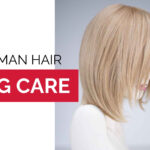If you are undergoing chemotherapy for cancer treatment then as well as dealing with the sickness and exhaustion, it’s also likely that you will experience some degree of hair loss. For many women, the hair loss associated with chemotherapy is the most emotionally charged and upsetting part of their cancer treatment. Their hair is an integral part of how they seem themselves and they don’t quite know how to approach living without it.
Some women choose to shave their hair at the start of their treatment so that they can be in control of how and when their hair falls out but deciding what to do next can still be difficult. The good news is that there are a wide range of stylish simple wigs and great sophisticated head options available now. If you don’t want to embrace and expose your thinning hair or shaved head, then you don’t have to. Here are some of the options available to you to help you deal with hair loss during cancer treatment.
Wigs and Other Head Coverings
There are a range of different head coverings for you to choose from including wigs and turbans. Those are the most popular options. Many women choose to embrace the process and have fun with their hair, experimenting with new hair styles and hair colours that they might not have tried before and trying out different types of turbans and scarves.
Before you take the plunge and shave your head, we recommend that you take plenty of pictures of your existing hairstyle from all angles. This will be particularly important if you want to choose a wig that resembles your original hair as closely as possible. These photos will also provide a useful point of reference when choosing other colours and styles that will suit your skin tone and face shape.
Some people find it difficult to get used to wearing a wig. Chemotherapy can leave your skin feeling sensitive, hot and itchy and for some this means that wearing a wig is irritating. One solution to that is to wear a wig cap or wig liner underneath your wig. This can protect your scalp while making the wig fit even more securely. These wig liners or caps also absorb sweat and oils from your scalp to protect your wig while keeping you more comfortable.
Another option is to wear a head scarf or turban, instead. These tend to be more lightweight than wigs and, because they are made of soft fabrics, they are also less likely to leave you feeling itchy or uncomfortable. Turbans and chemo hats can be particularly good if you are battling fatigue due to the chemotherapy as these types of head coverings are simple to put on and don’t require the styling that some wigs do.
Remember, don’t give up. It might take some experimentation to find the wig, turban, or other head covering that works best for you. Your needs can also change as hair loss begins, chemo continues, and then your hair begins to regrow after your cancer treatment has been completed. If you are in our area you can arrange a private appointment with us for a fitting so you can find your perfect looks. If you are located further away, feel free to contact our helpful team. Our experts will be happy to assist you.
Looking After Your Hair
Once your treatment has ended and your hair begins to grow back, it is important that you look after the emerging hairs so that it grows back as strong and as healthy as possible. In order to do this, you should wash your hair every two to three days, and only wash it with gentle, unmedicated products. If you’re having radiotherapy then ask your doctors whether you can wash your hair with shampoo at all. If that’s allowed your medical team may also be able to recommend which brands will work best for your unique situation.
Other tips to remember are when you’re drying your hair don’t rub it too hard with your towel. This could cause damage to your newly emerging hairs and could even lead them to fall out. Using a pillowcase that is made from natural fibres will help to protect your hair from damage while you sleep. Finally, protect your scalp from heat and cold. Using a wig, turban, scarf, or other hair covering is the easiest and most fashion-forward way to do this.
Coping with the Emotional Implications
Whilst looking after your hair and buying a wig can help you deal with the practical implications of hair loss, they cannot help you to deal with the emotional implications. Some of the best ways to prepare for losing your hair include talking to your friends and family and relying on their support or attending a support group for other cancer patients. There you will be able to talk to people who are going through the same thing and exchange tips on how to cope.
Looking like your pre-cancer self and feeling better about your appearance could help you remain motivated as you continue your cancer treatments.







Comments are closed.